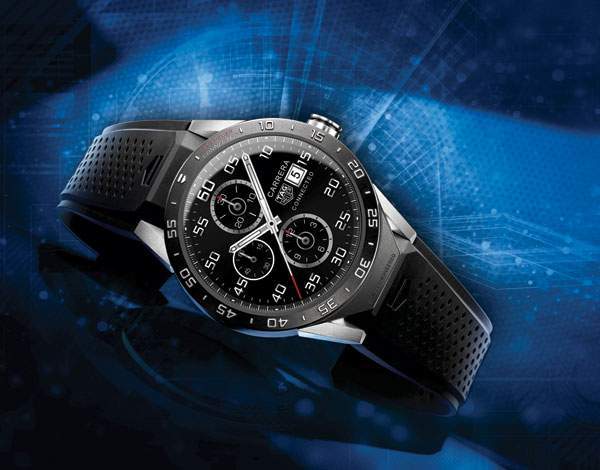
Jean-Claude Biver wants to go down in history as the entrepreneur who took on Apple — and won. The funny thing is, he might just do it.

Bernard Arnault, the richest man in France and the boss of LVMH, the world’s largest luxury goods conglomerate, is the last person you expect to see at a press conference. If he meets journalists at all these days, it is to show off his latest art gallery, the Fondation Louis Vuitton, in Paris, designed by the king of the curve, Frank Gehry. Yet there he was in his best suit and on his best behaviour on the 21st floor of the LVMH Tower in New York on a warm day in early November. The reason? He’s taking a gamble — a big gamble — and he wants to do all he can to win it.
Tag Heuer, one of LVMH’s watch brands, has become the first Swiss watchmaker to launch a Connected watch to take on the Apple Watch. It’s a joint venture with US chipmaker Intel and search and software giant Google. ‘This watch is an illustration of our creativity. It’s just a hint of what the group is going to do in the future,’ Arnault said.
He paid tribute to the man who has created the Connected watch, Jean-Claude Biver, singling out ‘his perseverance and his obstinacy’. To perseverance and obstinacy, many would add cheekiness, eccentricity, wit, mischief, iconoclasm, modesty, quiet confidence — and cheese.
There is no one quite like Biver in the Swiss watch industry — or indeed most industries. He never wears a suit and tie, preferring to dress down Monday to Sunday. Ask him a straight question — such as ‘How many Connected watches will you sell in the first year?’ — and he gives you a disarmingly straight answer: ‘I have no idea! I am not God!’
He prefers shouting to talking but, somehow, you don’t mind. Perhaps because he is modest to a fault. ‘The day you start to believe you are somebody, then you are in trouble. Doubt is my best friend. Thanks to my doubt, I am careful. I listen. I learn. I will never be a guy who says: “Yes, I know. Yes, I’m sure.”‘
Oddest — but most reassuringly Swiss of all — Biver never travels without cheese made from milk from his 60-strong herd of Alpine cows. He presented the world’s press with a giant wheel at the end of the press conference in New York and cut and handed out pieces. Arnault got something rather bigger — and much harder to take home in his luggage: a clanking cow bell.
Biver, in short, fits Steve Jobs’ description of ‘the crazy one, the misfit, the rebel, the troublemaker, the round peg in the square hole… the one who sees things differently and changes the world’. Which is useful, because that is exactly what he is trying to do.
Under Arnault’s gimlet eye, Biver has spent the past year studying the most hyped consumer product of the past year, the Apple Watch. He thinks his new Connected watch can beat it. How? ‘The Apple Watch has copied the iPhone on the wrist. This has a lack of sex appeal,’ he says. ‘Our watch is a watch, not a computer on your wrist — a big, strong, sexy watch.’

It certainly looks like a watch. It comes from the Carrera family of Tag Heuer, so it’s round. The dial is digital but looks analogue, with hour and minute markings and even shadows under the hands in bright light. It is always on, with the hands turning. By contrast, the Apple Watch is square and only turns itself on when you turn your wrist to your face, so you walk around most of the time with an inert black slab of glass just above your hand.
Made of grade-2 titanium with textured rubber or leather straps, the Connected watch looks luxurious. It comes with an upscale price tag, too — £1,100, compared with as little as £300 for the Apple watch. New red-gold models for men and women will come soon and will cost around £7,000. ‘Apple is still struggling to become a luxury brand,’ Biver says. ‘But we are luxury.’
Biver regards the Apple Watch as hard to use. The icons are too small to read, even on the larger of the two models. Using the crown to help to navigate is remarkably fiddly. So he has given the Connected watch a huge screen and made it instantly easy to understand and operate. A few taps and swipes take you to your calendar, email, messages and key apps.
The Connected watch does a lot untethered to your mobile phone, unlike the Apple watch, which only really works when you have your iPhone with you. Calendar, email and messages are cached and generate alerts even if your phone is switched off. Music can be downloaded and streamed via Bluetooth headphones.
Better still, the Connected watch has its own wifi connector, unlike the Apple watch. That means that provided you keep your mobile phone connected to wifi or the GSM network — say, in your office, home or hotel room — you can use all the functions of the watch on any wifi network you encounter.
And it does not matter if your mobile is an iPhone or a Samsung, Nexus or HTC or any other handset that runs on Google’s Android operating system. The Connected watch, which comes with 4GB of memory, works with both iOS and Android.
After Apple was lambasted for offering less than a day’s battery life, Biver, aided by Intel, insists the Connected watch will run for more than 24 hours on a single charge. Tag knows the last thing any of us wants to carry around is another bulky charger, so it hasmade its Connected watch charger light and very small.
The Apple Watch is outdated the moment you buy it and, worse, has to be thrown away when a new, better model arrives every two years. When a new model of the Connected watch comes out, owners can pay to have Tag Heuer install a mechanical movement to convert their old Connected watch into a traditional Carrera ‘for eternity’. Converting a Connected watch into a mechanical one ‘will end up costing only $200 more than if you had bought a mechanical Carrera to start with’, Biver says.
After 40-odd years in the watch business, during which time he revived both the Blancpain and Hublot brands, Biver almost retired two years ago — until Arnault asked him to leave his holiday home in the South of France and, over some Sancerre, persuaded him to head up LVMH’s watch division.
Now, with a bit of luck, he will get to write the final chapter of a storied career that might be the most important for him and his industry. In a few weeks’ time when sales figures are published, we will know if Biver has demonstrated that the future of watchmaking lies in the Alpine valleys where his cows graze, rather than, as Apple hopes, Silicon Valley.






